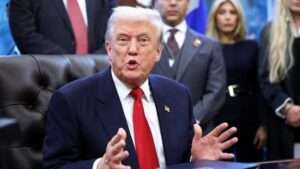In a significant escalation of Washington’s coercive economic strategy, President Donald Trump has signalled support for imposing tariffs of up to 500% on countries that continue purchasing Russian oil and other energy products. The proposal, rooted in the Senate-backed Sanctioning Russia Act of 2025, seeks to penalise not only Moscow but also third-party states whose energy imports indirectly sustain Russia’s wartime revenues.
The measure represents a dramatic shift from traditional sanctions, which typically target the offending nation directly. Instead, the U.S. is now considering a framework of secondary sanctions, effectively weaponising the American market to pressure major importers such as India and China. Analysts note that this approach mirrors the U.S. playbook during sanctions on Iran, but at a far more aggressive scale, signalling a willingness to challenge global trade alignments.
Strategically, Washington aims to undermine Russia’s capacity to finance its military operations in Ukraine by collapsing demand for its discounted crude. However, the proposal carries substantial diplomatic and economic risks. For India now one of the world’s top buyers of Russian crude such tariffs could disrupt bilateral trade, trigger retaliatory measures, and complicate its energy security calculus. China, meanwhile, is expected to resist any U.S. attempt to influence its energy supply chain.
While the legislation must still clear Congress, Trump’s endorsement indicates a harder U.S. line on global energy flows. The move underscores an emerging reality: energy geopolitics is increasingly inseparable from Washington’s sanctions architecture, with profound implications for global markets and diplomatic relations.


